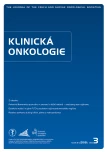Resection of Abdominal, Pelvic and Retroperitoneal Tumors
Authors:
Šimůnek Radim 3; Adámková-Krákorová Dagmar 2; Šefr Roman 1,3; Fait Vuk 1,3
Authors place of work:
Oddělení chirurgické onkologie, Masarykův onkologický ústav, Brno
1; Klinika komplexní onkologické péče, Masarykův onkologický ústav, Brno
2; Klinika operační onkologie, Masarykův onkologický ústav, Brno
3
Published in the journal:
Klin Onkol 2018; 31(3): 230-234
Category:
Kazuistiky
doi:
https://doi.org/10.14735/amko2018230
Summary
Background:
Mesenchymal malignancies are relatively rare tumors with distinct behaviors that are usually surgically removal. However, it is sometimes impossible to perform such surgery according to standardized procedures. In particular, surgical removal of intraperitoneal and retroperitoneal tumors differs among individuals.
Case reports:
We present two cases with intra-abdominal and retroperitoneal sarcomas who were treated at our comprehensive oncology center. The first patient was a 36-year-old male who was initially diagnosed with a tumor in the subrenal space that measured 95 × 90 × 140 mm, contacted the inferior vena cava and right kidney, and had the same blood supply as the upper pole of the right kidney. Primary histological analysis indicated that the tumor was a schwannoma. After further examinations, the tumor was removed and the right kidney was preserved. A ganglioneuroblastoma was diagnosed based on definitive histological analysis. Adjuvant radiotherapy was administered to the tumor bed. The patient is disease-free at 1 year after resection. The second patient was a 52-year-old male who was diagnosed with a liposarcoma in the retroperitoneal space that measured 50 × 36 × 15 cm and weighed 14 kg upon resection. Resection involved left-side nephrectomy and adrenalectomy. Adjuvant chemotherapy with IFO/ADM was administered. A recurrence in the tumor bed was resected 31 months after the primary resection. Three new foci appeared in the retroperitoneal space after another 18 months and were removed. Another recurrence in the left funiculus was removed after a further 6 months. The patient has been disease-free for 3 months.
Conclusions:
Treatment of soft tissue sarcoma is complex and should be performed at a comprehensive oncology center if possible. Preoperative biopsy is essential.
Key words:
sarcoma – surgical procedures
Supported by MZ ČR-RVO (MOÚ,00209805).
The authors declare they have no potential conflicts of interest concerning drugs, products, or services used in the study.
The Editorial Board declares that the manuscript met the ICMJE recommendation for biomedical papers.
Submitted: 6. 3. 2018
Accepted: 20. 3. 2018
Zdroje
1. Singer S, Antonescu CR, Riedel E et al. Histologic subtype and margin of resection predict pattern of recurrence and survival for retroperitoneal liposarcoma. Ann Surg 2003; 238 (3): 358–370. doi: 10.1097/01.sla.0000086542.11899.38.
2. Tan MC, Yoon SS. Surgical management of retroperitoneal and pelvic sarcomas. J Surg Oncol 2015; 111 (5): 553–561. doi: 10.1002/jso.23840.
3. Bonvalot S, Raut CP, Pollock RE et al. Technical considerations in surgery for retroperitoneal sarcomas: position paper from ESurge,a master class in sarcoma surgery, and EORTC-STBSG. Ann Surg Oncol 2012; 19 (9): 2981–2991. doi: 10.1245/s10434-012-2342-2.
4. Gyorki DE, BrennanMF. Management of recurrent retroperitoneal sarcoma. J Surg Oncol 2014; 109 (1): 53–59. doi: 10.1002/jso.23463.
5. van Dalen T, Hoekstra HJ, van Geel AN et al. Locoregional recurrence of retroperitoneal soft tissue sarcoma: second chance of cure for selected patients. Eur J Surg Oncol 2001; 27 (6): 564–568. doi: 10.1053/ejso.2001. 1166.
6. Gronchi A, De Paoli A, Dani C et al. Preoperative chemoradiation therapy for localised retroperitoneal sarcoma: a phase III study from the Italian Sarcoma Group. Eur J Cancer 2014; 50 (4): 784–792. doi: 10.1016/j.ejca.2013. 11.021.
7. Bonvalot S, Rivoire M, Castaing M et al. Primary retroperitoneal sarcomas: a multivariate analysis of surgical factors associated with local control. J Clin Oncol 2009; 27: 31–37. doi: 10.1200/JCO.2008.18. 0802.
Štítky
Dětská onkologie Chirurgie všeobecná OnkologieČlánek vyšel v časopise
Klinická onkologie

2018 Číslo 3
- Metamizol jako analgetikum první volby: kdy, pro koho, jak a proč?
- Cinitaprid – v Česku nová účinná látka nejen pro léčbu dysmotilitní dyspepsie
- Management pacientů s MPN a neobvyklou kombinací genových přestaveb – systematický přehled a kazuistiky
- Neodolpasse je bezpečný přípravek v krátkodobé léčbě bolesti
- Management péče o pacientku s karcinomem ovaria a neočekávanou mutací CDH1 – kazuistika
Nejčtenější v tomto čísle
- Potenciál flavonoidu quercetinu v prevenci a léčbě nádorů – současný stav výzkumu
- Neuroendokrinné neoplázie gastrointestinálneho traktu z pohľadu histopatológie
- Resekce sarkomu dutiny břišní, pánve a retroperitonea
- Možná úloha ľudských herpetických vírusov podčeľade Alphaherpesvirinae pri vzniku niektorých nádorových ochorení
